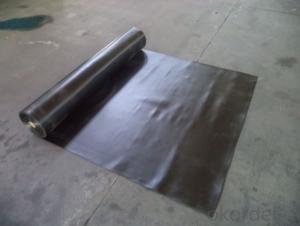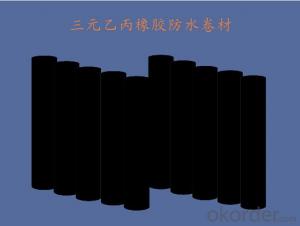EPDM Swimming Waterproof EPDM Pond Liner
- Loading Port:
- Qingdao
- Payment Terms:
- TT OR LC
- Min Order Qty:
- 2000 m²
- Supply Capability:
- 100000 m²/month
OKorder Service Pledge
OKorder Financial Service
You Might Also Like
EPDM waterproofing membrane
1. Brief Introduction:
It is a kind of self-adhesive waterproof coiled material based on polymer rubber and superior asphalt, together with polyethylene film and aluminum foil as surface material or no film(Double-sided self-adhesive). And it adopts the package preventing-adhesion-isolation-layer package, and dividing into no fiber and polyester fiber two parts.The coiled material has perfect performances, simple operation, non-pollution and etc.
2. Characters:
1)Good flexibility, creep properties and malleability, and the superior adapting ability to the deformation of the primary stress generated.
2). Tight adhesion between waterproof layer and basic layer, no channeling water. Having self healing ability after piercing.
3).Operation without heating. And possessing the reliability of pasting by itself with super strong connection of sheet materialand adhesion of same base.
4). Convenient and safe operation, no pollution to the environment.
ITEM | STANDARO REQUEST | |
Tensile strength at breaking,normal temperature,Mpa | ≥7.5 | |
Elongation at breaking, % | ≥450 | |
Tearing strenght,KN/m | ≥25 | |
Bending at low temperature | ≤-40°C | |
Water impermeability,0.1Mpa×30min | Impermeability | |
Hot air aging 80°C×168h | Unchanging of tensile strength at breaking,% | ≥80 |
Unchanging of elongation at breaking,% | ≥70 | |
Appearance of 100% elongation | No crack | |
Property of anti alkali 10% Ca(OH)2×168h normal temperature | ≥80 | |
≥80 | ||
3. Application:
1),Roofs, Basement, Toilet
2),Industrial and civil building waterproofing
3),Geosynthetic liner for swimming pool, channels, irrigation system
4),Especially suit for projects with high requirements in durability, anti-corrosion anddeformation
4. Package and Storage:
Each Roll with one plastic bag with or without pallets.
Keep in dry and ventilated place. Avoid shining and raining. Height of stack not more than 5 layers. Shelf life:12 months.

5. Specification:
Type | EPDM Waterproof Rubber Membrane | |||
Material | EPDM Rubber | |||
Thickness | 1.0mm | 1.2mm | 1.5mm | 2.0mm |
Size | 1.2m(width) * 20m(length)/roll | |||
Type | Vulcanized | |||
Pattern | Non-reinforced(homogeneous) | |||
Packing | 24sqm--80sqm/roll, with plastic bag | |||
Color | Black | |||
Application | Roofs, basement, pond, Lake, steel structure roof, swimming pool, underground, tunnel, etc | |||
6. Installations:
1. adhere the EPDM membrane directly to the smooth and clean substrate like concrete deck, insulation board, etc.
2. Adjust membrane to make sure the overlaps is no less than 10cm and wiped clean.
3. Then, apply special adhesive evenly to both the substrate and the membrane laps or seam tape.
4. After minutes, press it securely and finish with sealant.
5. Some photos:
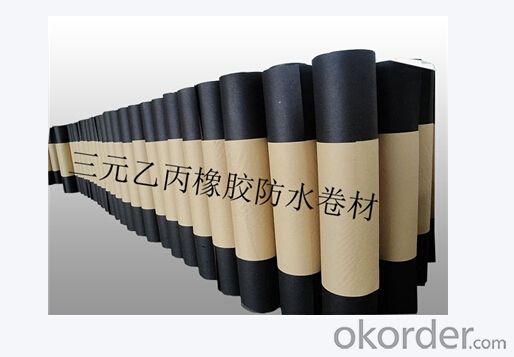
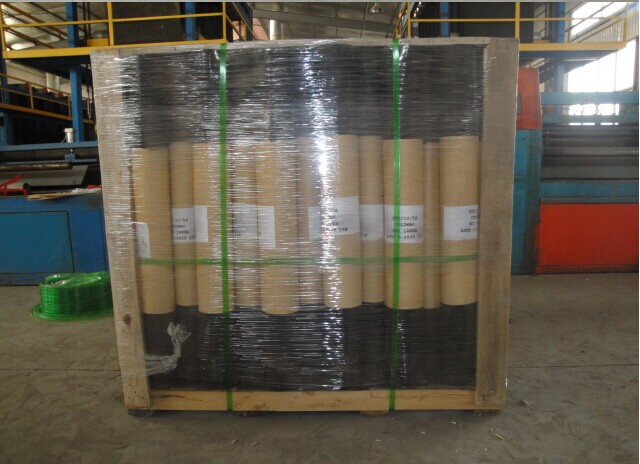
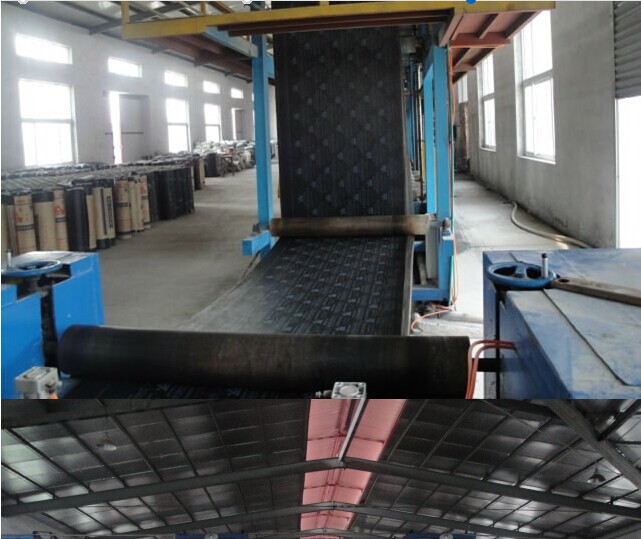

- Q:Can a waterproofing membrane be applied to vertical surfaces?
- Yes, a waterproofing membrane can be applied to vertical surfaces. In fact, waterproofing membranes are commonly used on vertical surfaces such as walls, foundations, and retaining walls to protect against water infiltration. These membranes are specifically designed to adhere to vertical surfaces and provide a protective barrier against water, preventing moisture from seeping into the structure. The application process typically involves cleaning and preparing the surface, applying a primer if necessary, and then installing the waterproofing membrane using a suitable adhesive or mechanical fastening system. This ensures that the membrane forms a continuous and secure seal, effectively preventing water penetration. Overall, waterproofing membranes offer an effective solution for waterproofing vertical surfaces and are widely used in construction and building maintenance projects.
- Q:Are waterproofing membranes resistant to alkalis?
- Yes, waterproofing membranes are generally resistant to alkalis. Alkalis are substances with a high pH level, such as sodium hydroxide or potassium hydroxide, and can be found in various construction materials, including concrete. Waterproofing membranes are specifically designed to provide a protective barrier against water and other potentially damaging substances. They are typically made from materials such as modified bitumen, PVC, or EPDM, which have excellent resistance to alkalis. This resistance ensures that the waterproofing membrane remains intact and effective, even when exposed to alkaline substances. It is important to choose a waterproofing membrane that is specifically designed for alkali resistance when working with materials or environments that contain high levels of alkalis.
- Q:Can a waterproofing membrane be used on concrete slabs or foundations?
- Yes, a waterproofing membrane can be used on concrete slabs or foundations. It serves as a protective barrier against water penetration, preventing moisture-related issues such as leaks, mold, and structural damage. The membrane is typically applied to the exterior surface of the concrete to create a waterproof seal.
- Q:Is the asphalt waterproofing membrane facing the side?
- 2, pre-shop anti-stick method: This kind of membrane to synthetic polymer self-adhesive coil mainly single-sided self-adhesive or double-sided self-adhesive. In the construction of the floor, the coiled surface of the coil facing the day, the membrane surface does not do protective layer, in the above bar reinforced concrete pouring. In the construction of the wallboard, for the foundation pit and the structure of the wall spacing is too small, the envelope as a concrete structure of the outer wall of the wall panels, wall panels only support the internal mold, waterproof membrane nails nailed to the envelope , The adhesive surface facing the basement structure, the concrete directly with the waterproofing membrane bonding surface combination.
- Q:Can a waterproofing membrane be used for marinas and boat docks?
- Yes, a waterproofing membrane can be used for marinas and boat docks. Waterproofing membranes are designed to create a barrier against water penetration, making them an ideal solution to protect structures such as marinas and boat docks from water damage and corrosion. These membranes provide a durable and long-lasting waterproofing solution that can withstand the harsh marine environment.
- Q:Are waterproofing membranes environmentally friendly?
- Depending on the type and installation, waterproofing membranes have the potential to be environmentally friendly. Some membranes are manufactured with recycled materials, which reduces the need for new resources and waste generation. Moreover, certain membranes are designed for durability and longevity, reducing the frequency of replacement and overall environmental impact. Nevertheless, it is crucial to consider the potential adverse environmental effects of waterproofing membranes. Some membranes are composed of synthetic materials that may release harmful chemicals into the environment during production or degradation. Furthermore, improper installation or disposal of these membranes can result in pollution and contamination of soil and water sources. To ensure the environmental friendliness of waterproofing membranes, it is essential to select products certified as sustainable or eco-friendly by reputable organizations. Additionally, hiring experienced professionals for correct installation minimizes the risk of leaks or damage that could lead to environmental issues. Lastly, proper disposal of old or damaged membranes is vital to prevent pollution and ensure responsible waste management. In conclusion, waterproofing membranes can be environmentally friendly if appropriate materials are chosen, installation is performed correctly, and disposal is handled responsibly. It is crucial to assess the environmental impact of these membranes and make informed choices to minimize any negative effects.
- Q:Can a waterproofing membrane be used on tunnels with subway systems?
- Yes, a waterproofing membrane can be used on tunnels with subway systems. Waterproofing membranes are commonly used in underground construction projects, including tunnels and subway systems, to prevent water infiltration. These membranes act as a protective barrier, preventing water from entering the tunnel and causing damage to the infrastructure. By using a waterproofing membrane, the tunnel structure can be effectively protected and the subway system can operate safely and efficiently.
- Q:Waterproof building materials after the construction of drums, bubble is what reason?
- Causes and prevention of drums: Cause 1: If the membrane waterproof layer if the site is not solid, there is moisture, sunlight or artificial heat in the impact of the internal volume expansion, resulting in drums, the formation of the size of the bubble. Preventive measures: leveling layer should be kept flat, clean, dry, grass-roots treatment agent should be brushing evenly, which is to prevent the drum from the main measures. Raw materials in the transport and storage process, should pay attention to moisture and water. To avoid the rainy day, fog, big wind climate conditions under construction, to prevent grass-roots moisture. When the roof base should not be dry, and anxious to paving the membrane, the use of exhaust roof approach (exposed single layer of waterproofing membrane should not be used).
- Q:Can a waterproofing membrane be used on modified bitumen roofs?
- Yes, a waterproofing membrane can be used on modified bitumen roofs. In fact, it is a common practice to install a waterproofing membrane over modified bitumen roofs to provide an additional layer of protection against water infiltration. This is especially important in areas with heavy rainfall or where the roof is prone to frequent exposure to water. The waterproofing membrane helps to seal any potential cracks or gaps in the modified bitumen roofing system, preventing water from seeping through and causing damage to the underlying structure. Additionally, the waterproofing membrane can also enhance the overall durability and longevity of the roof by protecting it from the harmful effects of moisture.
- Q:Can a waterproofing membrane be used for a planter box?
- Indeed, a planter box can benefit from the use of a waterproofing membrane. The primary function of a waterproofing membrane is to impede the intrusion of water into the surface it is applied to. Consequently, it is a suitable choice for safeguarding the planter box against moisture-induced harm. By employing a waterproofing membrane on the interior of the planter box, a barrier is established that thwarts the infiltration of water and the potential harm it may inflict upon the wood or material of the planter box. This can prove particularly advantageous when the planter box is persistently exposed to water, such as in outdoor settings or for hydroponic gardening endeavors. In essence, the utilization of a waterproofing membrane for a planter box can contribute to its longevity and ensure its sustained good condition.
1. Manufacturer Overview |
|
|---|---|
| Location | |
| Year Established | |
| Annual Output Value | |
| Main Markets | |
| Company Certifications | |
2. Manufacturer Certificates |
|
|---|---|
| a) Certification Name | |
| Range | |
| Reference | |
| Validity Period | |
3. Manufacturer Capability |
|
|---|---|
| a)Trade Capacity | |
| Nearest Port | |
| Export Percentage | |
| No.of Employees in Trade Department | |
| Language Spoken: | |
| b)Factory Information | |
| Factory Size: | |
| No. of Production Lines | |
| Contract Manufacturing | |
| Product Price Range | |
Send your message to us
EPDM Swimming Waterproof EPDM Pond Liner
- Loading Port:
- Qingdao
- Payment Terms:
- TT OR LC
- Min Order Qty:
- 2000 m²
- Supply Capability:
- 100000 m²/month
OKorder Service Pledge
OKorder Financial Service
Similar products
New products
Hot products
Hot Searches
Related keywords
